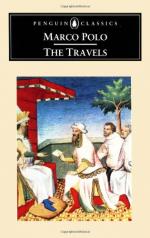NOTE 1.—Ramusio, the printed text of the Soc. de Geographie, and most editions have Amu; Pauthier reads Aniu and considers the name to represent Tungking or Annam, called also Nan-yue. The latter word he supposes to be converted into Anyue, Aniu. And accordingly he carries the traveller to the capital of Tungking.
Leaving the name for the present, according to the scheme of the route as I shall try to explain it below, I should seek for Amu or Aniu or Anin in the extreme south-east of Yun-nan. A part of this region was for the first time traversed by the officers of the French expedition up the Mekong, who in 1867 visited Sheu-ping, Lin-ngan and the upper valley of the River of Tungking on their way to Yun-nan-fu. To my question whether the description in the text, of Aniu or Anin and its fine pastures, applied to the tract just indicated, Lieut. Garnier replied on the whole favourably (see further on), proceeding: “The population about Sheu-ping is excessively mixt. On market days at that town one sees a gathering of wild people in great number and variety, and whose costumes are highly picturesque, as well as often very rich. There are the Pa-is, who are also found again higher up, the Ho-nhi, the Khato, the Lope, the Shentseu. These tribes appear to be allied in part to the Laotians, in part to the Kakhyens.... The wilder races about Sheuping are remarkably handsome, and you see there types of women exhibiting an extraordinary regularity of feature, and at the same time a complexion surprisingly white. The Chinese look quite an inferior race beside them.... I may add that all these tribes, especially the Ho-nhi and the Pa-i, wear large amounts of silver ornament; great collars of silver round the neck, as well as on the legs and arms.”
Though the whiteness of the people of Anin is not noticed by Polo, the distinctive manner in which he speaks in the next chapter of the dark complexion of the tribes described therein seems to indicate the probable omission of the opposite trait here.
The prominent position assigned in M. Garnier’s remarks to a race called Ho-nhi first suggested to me that the reading of the text might be ANIN instead of Aniu. And as a matter of fact this seems to my eyes to be clearly the reading of the Paris Livre des Merveilles (Pauthier’s MS. B), while the Paris No. 5631 (Pauthier’s A) has Auin, and what may be either Aniu or Anin. Anyn is also found in the Latin Brandenburg MS. of Pipino’s version collated by Andrew Mueller, to which, however, we cannot ascribe much weight. But the two words are so nearly identical in mediaeval writing, and so little likely to be discriminated by scribes who had nothing to guide their discrimination, that one need not hesitate to adopt that which is supported by argument. In reference to the suggested




